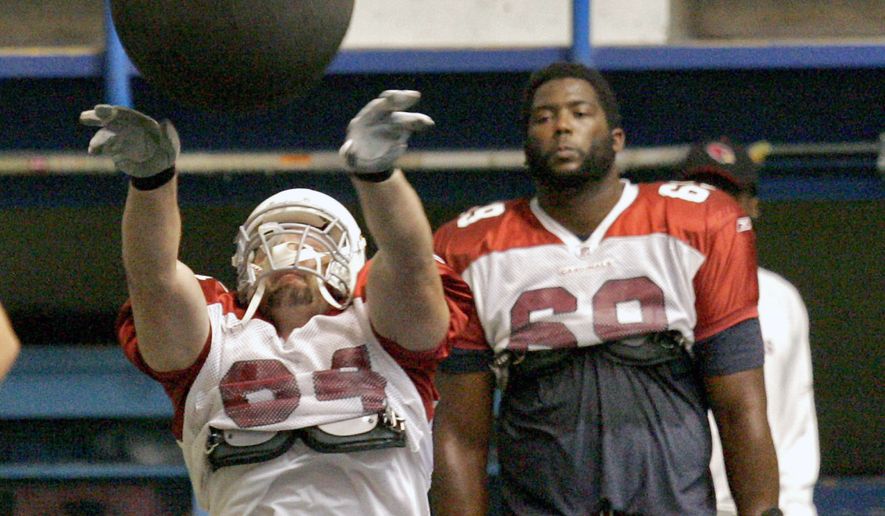Scott Peters decided he would play in the NFL when he was 14 years old. Between then and 2006, when Peters was a veteran offensive lineman for the Carolina Panthers, most of the conventional wisdom he’d been taught had to do with being big, fast and strong.
So, when an ankle injury landed him in a martial arts gym trying his hand at Brazilian jiu jitsu because it could be practiced on the ground and off his feet, Peters was surprised when much smaller men were kicking all 300-plus pounds of him from here to Sunday.
“I’m like, what are they doing? I was a big, strong, NFL player,” Peters said. “How was this possible?”
That question led Peters to his eventual career after football and, earlier this month, to Redskins Park where he worked with the team’s offensive linemen for two days.
He coached techniques for engaging in contact rooted in the principles of leverage and control that allowed middle-aged men with office jobs to deliver so many unexpected butt-kickings.
The most important byproduct of Peters’ training is that, when it sticks, players who make their living in the collision-zone along the line of scrimmage stop leading with their heads.
“I don’t think head contact is ever going to be fully eliminated, but there’s certain ways to, I mean, when we’re pass-protecting, we want to keep our heads out,” said center Spencer Long who, with other returning guards and centers, worked most closely with Peters.
Head-on collisions have always been part of the game, and Peters needed a circuitous route to even consider the possibility that they could be eliminated.
When Peters retired from the NFL after the 2008 season with the Arizona Cardinals, he opened a mixed martial arts gym in Scottsdale called Fight Ready. There, he learned about the techniques underlying various disciplines, and the more he learned, the more he wondered if the same principles could be useful in football.
In 2012, Peters got his first big opportunity to teach those techniques when the University of Washington hired him as a strength and conditioning coach. The Huskies went on to have the best rushing season in team history. Peters was thrilled by that result alone. Then, a trainer called to tell him that UW had had no diagnosed concussions or neck stingers that year, which the trainer had never seen happen before.
Safety wasn’t Peters’ original focus but, like most players, he’d had concussions and worried about them.
“The funny thing is when I played it was like very few of us had, it wasn’t that often you’d get a diagnosed concussion,” Peters said. “But when you learned about the symptoms, learned what is a concussion, you’re like ’Oh my gosh, that’s a concussion? I think I had one on every play.’ You know? So that’s scary stuff.”
When he realized the same practices that could help linemen play better could also keep them safer, Peters changed direction. He started Safe Football, a skill development program that teaches players how to block, beat blocks and tackle by using their hands and leverage, not their heads.
Safe Football works with NFL teams on down to youth programs. This offseason, Peters has worked with the Colts, Browns, Steelers and Cowboys as well as the Redskins.
Peters was invited to Ashburn by Redskins offensive line coach Bill Callahan, who found out about his work through legendary offensive line coach Jim McNally. Callahan visited Peters’ gym in Scottsdale, and decided he wanted to bring him up to work with players.
“It was great to have him in there because he’s masterful, and it’s great to have a person that has martial arts experience and that can apply it to football,” Callahan said. “A lot of guys have martial arts experience but can’t apply it to our game.”
One way in which Peters differentiates himself is by making sure that every drill he runs with NFL linemen is designed with an eye toward their particular scheme.
“He’s going to be a hell of a coach and I’m certain that someone is going to hire him in this league because he brings that value to the team,” Callahan said.
For now, youth and high school teams, though, are Safe Football’s main focus. If Peters can teach safer techniques earlier, players don’t have bad habits to correct later. More importantly, they spend fewer years of their football lives taking unnecessary hits.
At the college level, because of limited practice time and the emphasis on producing players with traits that will get them to the NFL, strength and conditioning is prioritized over skill development. Players get bigger, faster and stronger without learning how to use their bodies effectively or safely.
“Guys are just running around like trains out of control or runaway beer trucks hitting each other, and of course you’re going to get more guys scraped off the ground and more injuries,” Peters said.
Just by watching a game of college football, Peters can tell which players have been coached to understand leverage. A lineman who leads with his head has not been; one who finishes a game with a clean helmet likely has.
Peters likened good coaching to teaching a player to swim instead of throwing him a life raft. The way he describes it, though, it sounds more like teaching someone to swim instead of telling them to walk through neck-high water: the movements may not feel as natural, but they’re much more efficient.
“We need coaches to step up a little bit,” Peters said. “A lot. And redefine what [coaching] is. You can’t just yell at a kid and throw your hat and curse him. You have to actually teach him.”
Professionals tend to be more receptive than amateurs, in Peters’ experience. If he can show them that his techniques work, NFL players will be open to trying them.
“You’ll find the oldest, crustiest guys — these guys that don’t want to hear about it — I can win those guys over because I’ll go, ’Hey, you can tell me this is soft but I’m going to ask you to feel it and tell me if it’s soft’,” Peters said.
The game check is ultimately the most powerful motivator. If Peters can prove that what he preaches will lead to better performance, then players will buy in.
Focusing on safety without considering performance is pointless, Peters said, because NFL players are far more willing to sacrifice the former for the latter than to do the opposite.
“You can’t tell them ’Hey man, you’re going to die a day after you retire.’ They’ll be like ’Whatever, I’m doing it.’ You cannot convince these guys,” Peters said. “That’s not the idea. The idea is look, this is better, and it is. It truly is.”
• Nora Princiotti can be reached at nprinciotti@washingtontimes.com.




Please read our comment policy before commenting.